Sally Murphy's Blog, page 13
March 2, 2023
Poetry Friday: Dorothea Mackellar
It’s Poetry Friday and I have had a super poetic week. I have been lucky enough to spend time with young writers running poetry writing masterclasses, courtesy of the Literature Centre and which I will write more about in a separate post.
Then, on Wednesday a lovely thing was announced. I am now a Patron of the Dorothea Mackellar Poetry Awards, a nationwide poetry writing contest for school aged writers. Here’s the announcement.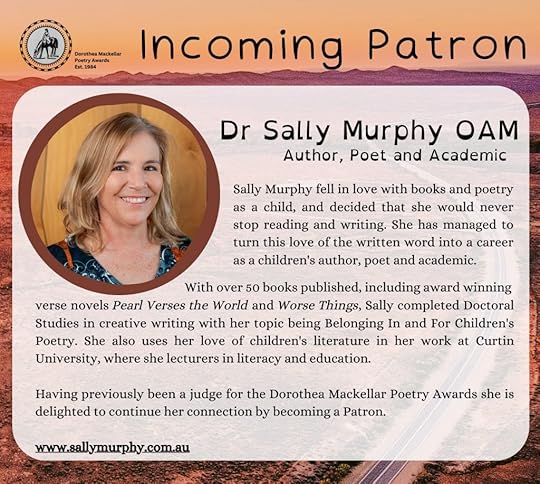
It makes me sound quite good, doesn’t it????
Though I am very humbled to be asked to do this, I am also very very excited. Poetry, writing and young people are my life’s work! If I can play any role in inspiring children to read and write poetry, I will. So when I was asked to be a Patron – after I picked myself up off the floor – I said a very emphatic YES.
SO, to celebrate, I thought it might be nice to share Mackellar’s best known poem, which I not only remember learning by rote in school, but also remember learning to sing it for a royal visit (which at the time was very exciting, though these days I am firmly of the belief Australia should become a republic). Here it is:
My Countryby Dorothea Mackellar
The love of field and coppice,
Of green and shaded lanes.
Of ordered woods and gardens
Is running in your veins,
Strong love of grey-blue distance
Brown streams and soft dim skies
I know but cannot share it,
My love is otherwise.
I love a sunburnt country,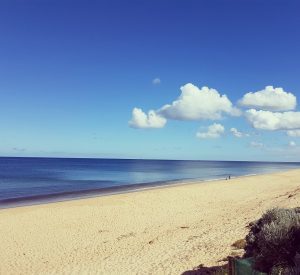
A land of sweeping plains,
Of ragged mountain ranges,
Of droughts and flooding rains.
I love her far horizons,
I love her jewel-sea,
Her beauty and her terror –
The wide brown land for me!
A stark white ring-barked forest
All tragic to the moon,
The sapphire-misted mountains,
The hot gold hush of noon.
Green tangle of the brushes,
Where lithe lianas coil,
And orchids deck the tree-tops
And ferns the warm dark soil.
Core of my heart, my country!
Her pitiless blue sky,
When sick at heart, around us,
We see the cattle die –
But then the grey clouds gather,
And we can bless again
The drumming of an army,
The steady, soaking rain.
Core of my heart, my country!
Land of the Rainbow Gold,
For flood and fire and famine,
She pays us back threefold –
Over the thirsty paddocks,
Watch, after many days,
The filmy veil of greenness
That thickens as we gaze.
An opal-hearted country,
A wilful, lavish land –
All you who have not loved her,
You will not understand –
Though earth holds many splendours,
Wherever I may die,
I know to what brown country
My homing thoughts will fly.
And here you can hear it read by the poet, with images that try to capture the essence of the words:
And here you can read more of her work
If you are in Australia and are a teacher or parent of school aged young people, do encourage them to consider entering the competition for 2023, which is now open. There is an optional theme, The Winding Road, and all the details can be found here.
And now, this patron is off to patronise the rest of the Poetry Friday posts for today. No winding roads – if you want to join me, you can head straight to Tanita’s website where you will find the Roundup.
What I Read in February 2023
February is over so it’s time to share my reading for the month. A shorter month, and a super busy one, but I read 11 books in amongst that busyness – some on audio on some long drives but most in hard copy. My favourite? A verse novel – Grace Notes by Karen Comer.
Here’s what else I read:
Children’s Books Cop and Robber by Tristan Bancks (Puffin, 2022). For middle grade readers, this is part action adventure, and part moral dilemma. Nash has to balance his love and loyalty to his dad, who wants Nash to help him commit a robbery, and his mum, who is a local cop.
Cop and Robber by Tristan Bancks (Puffin, 2022). For middle grade readers, this is part action adventure, and part moral dilemma. Nash has to balance his love and loyalty to his dad, who wants Nash to help him commit a robbery, and his mum, who is a local cop. Waiting for the Storks, by Katrina Nannestad (ABC Books, 2022). I would read a shopping list written by Katrina! She has very quickly become of my favourite writers, even though her books have the capacity to break my heart. The story of Zofia, a Polish girl taken by German soldiers because of her blonde hair and blue eyes. Challenging, because it is set during WW2, but still just beautiful.
Waiting for the Storks, by Katrina Nannestad (ABC Books, 2022). I would read a shopping list written by Katrina! She has very quickly become of my favourite writers, even though her books have the capacity to break my heart. The story of Zofia, a Polish girl taken by German soldiers because of her blonde hair and blue eyes. Challenging, because it is set during WW2, but still just beautiful.
 Bad Grammar: A School for Gentlemen, by Nathan Luff Being a wordsmith, I first thought this would be a book about language (lol) but quickly realised it was about that other kind of grammar – a school. Marcus is packed off to a school for bad boys – or misfits. And he’s not happy about it. A fun adventure.Books for Young Adults
Bad Grammar: A School for Gentlemen, by Nathan Luff Being a wordsmith, I first thought this would be a book about language (lol) but quickly realised it was about that other kind of grammar – a school. Marcus is packed off to a school for bad boys – or misfits. And he’s not happy about it. A fun adventure.Books for Young Adults
 Grace Notes, by Karen Comer (Lothian, 2023). Verse novels are my favourite kind of novels – narrative wrapped up in poetry is a perfect means to covey a vast range of themes and emotions. So as soon as I hear about this one I raced off and bought it – and wasn’t disappointed. The dual stories of Grace, a violinist whose parents don’t approve of her goal to be a professional musician, and Crux, who wants to be a street artist but has promised his Dad he’ll wait till he’s finished school. When Crux paints a mural of Grace, they meet, and together they navigate their parental pressures, as well as the unfolding Covid 19 pandemic. Moving and beautifully told.Books for Adults
Grace Notes, by Karen Comer (Lothian, 2023). Verse novels are my favourite kind of novels – narrative wrapped up in poetry is a perfect means to covey a vast range of themes and emotions. So as soon as I hear about this one I raced off and bought it – and wasn’t disappointed. The dual stories of Grace, a violinist whose parents don’t approve of her goal to be a professional musician, and Crux, who wants to be a street artist but has promised his Dad he’ll wait till he’s finished school. When Crux paints a mural of Grace, they meet, and together they navigate their parental pressures, as well as the unfolding Covid 19 pandemic. Moving and beautifully told.Books for Adults
 Why Does It Still Hurt?: how the power of knowledge can overcome chronic pain, by Paul Biegler (Scribe, 2022). I found this a useful insight into chronic pain, its causes and the connection between our brain and pain in the rest of our body. I’m on a bit of a quest for such information this year, so you might see quite a few health type books popping up in my monthly reads.
Why Does It Still Hurt?: how the power of knowledge can overcome chronic pain, by Paul Biegler (Scribe, 2022). I found this a useful insight into chronic pain, its causes and the connection between our brain and pain in the rest of our body. I’m on a bit of a quest for such information this year, so you might see quite a few health type books popping up in my monthly reads.
 The Beekeeper of Aleppo , by Christy Lefteri (Bonnier, 2020). Wow. I have been meaning to get around to this book for a very long time. Glad I finally did. You should read it too.
The Beekeeper of Aleppo , by Christy Lefteri (Bonnier, 2020). Wow. I have been meaning to get around to this book for a very long time. Glad I finally did. You should read it too.
 A Grief Observed, by C.S. Lewis. I can’t remember who recommended this book to me, but it’s been there waiting to be read for some time, and now I’ve read it. Didn’t love it, but interesting to learn about Lewis’s experience of grief.
A Grief Observed, by C.S. Lewis. I can’t remember who recommended this book to me, but it’s been there waiting to be read for some time, and now I’ve read it. Didn’t love it, but interesting to learn about Lewis’s experience of grief.
 Dracula: Popular Penguins, by Bram Stoker. I listened tot he Audible version of this classic, which I hadn’t read before. Really interesting story telling. I love how it is woven.
Dracula: Popular Penguins, by Bram Stoker. I listened tot he Audible version of this classic, which I hadn’t read before. Really interesting story telling. I love how it is woven.
 Divergent Mind: Thriving in a World That Wasn’t Designed for You, by Jenara Nerenberg(Harper One, 2021). Oh gosh I felt so very seen reading this book. The title says it all – this is a book all about neurodivergence, especially in women, and I learnt a lot.
Divergent Mind: Thriving in a World That Wasn’t Designed for You, by Jenara Nerenberg(Harper One, 2021). Oh gosh I felt so very seen reading this book. The title says it all – this is a book all about neurodivergence, especially in women, and I learnt a lot.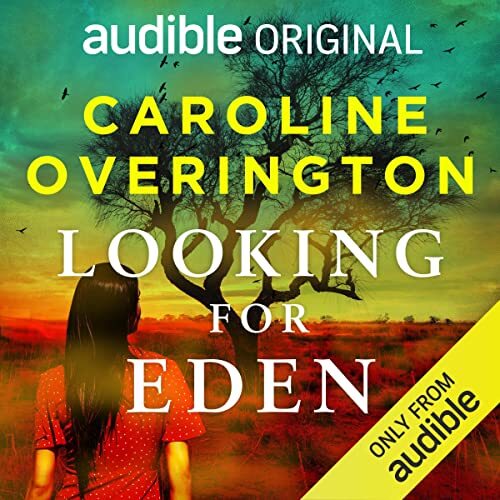 Looking for Eden, by Caroline Overington (Audible original). this was a fairly easy listen – an audio-only book with some mystery, some family issues and twists and turns.
Looking for Eden, by Caroline Overington (Audible original). this was a fairly easy listen – an audio-only book with some mystery, some family issues and twists and turns.
 Miss Potter: The Novel, by Richard Maltby (F. Warne & Co, 2006). What is special about this book is that I found it! On a bench in the local park. AND it was left there deliberately – as a Book Crossing Book. I have always always wanted to find a Book Crossing Book and, now that I’ve found and read one, I will leave it somewhere else, very soon – and leave some other books places too. I love Bookcrossing!
Miss Potter: The Novel, by Richard Maltby (F. Warne & Co, 2006). What is special about this book is that I found it! On a bench in the local park. AND it was left there deliberately – as a Book Crossing Book. I have always always wanted to find a Book Crossing Book and, now that I’ve found and read one, I will leave it somewhere else, very soon – and leave some other books places too. I love Bookcrossing!So that brings my total for the year to 23. I’m not aiming for a specific total this year, but suspect the number will be highish at this rate. What have you been reading.
February 20, 2023
Teacher Tuesday: Poetree
It’s Teacher Tuesday and this week I am offering a simple idea for a classroom display that also helps you grow a love of poetry. I call it a poetree.
The idea is very simple: on a whiteboard, or a large sheet of poster paper (the bigger the better) draw an outline of a tree. Here’s an example, drawn for me by a generous audience member at a conference a few years ago:
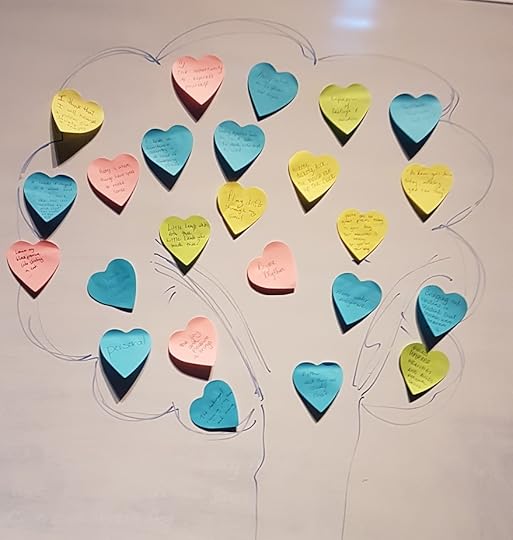
Once you have the outline, provide sticky notes (you can see I used heart shape ones) or cut out leaves and ask your students to write their favourite lines of poetry to fill the tree up. Or you can have them write small poems, such as haiku or hay(na)ku instead.
If they don’t have favourite lines of poetry, it’s time they did! Add a basket or shelf of poetry books nearby and allow students to choose lines from there.
You can also make your poetree three dimensional using a large pot plant, or branch, or, if there is a tree near your classroom, hanging poems on that – either for a pop up display or, if you laminate them, for longer.
Want more poetry ideas? My book Teaching Poetry for Pleasure and Purpose (PETAA, 2021) contains lots of teaching ideas,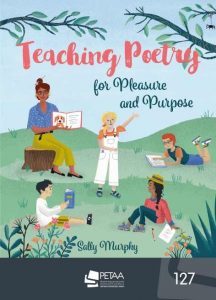 support to find resources and poems by a range of poets including myself. There is even a shape poem called, coincidentally Poetree.
support to find resources and poems by a range of poets including myself. There is even a shape poem called, coincidentally Poetree.
I’ d love to hear if you try this idea, or if you have your own poetry teaching ideas to share. Otherwise, I’ll see you here next Teacher Tuesday.
February 16, 2023
Poetry Friday: Small Things
Last Friday I wrote about the big thing I was getting ready to do – swim the 3.6 km around the Busselton Jetty, in an annual race.
On Sunday I did that big thing – and came out of the water feeling accomplished and pleased that, in spite of having an

After the race.
interrupted preparation/training this year, I still did a time I was really happy with.
But, that big thing, while it was lovely, was topped off by a seemingly small thing. After the swim, I ran into a friend (hello Julie!) I hadn’t seen for at least two years, who had also swum in the event. That was lovely in itself – but she told me that she had read my poem last Friday, and that while she was swimming it was in her head. Isn’t that just a lovely thing – to think of my swimming poem being in another swimmer’s head as she swam?
Later that day I had a text message from my mum (hi Mum!), who lives two hours away – and she wanted to tell me that she’d dropped in on my Poetry Friday post too, and that she’d been thinking about the poem – and me – while I was swimming. So there was my poem swimming around in Mum’s head too!
On Tuesday I posted my weekly Teacher Tuesday post, which was, perhaps unusually, not about poetry this week. But on Wednesday, at a work meeting, a colleague (and friend – Hi Jane!) told me how much she loved that post – and wished she’d had such a practical strategy when she was a classroom teacher. What a generous piece of feedback.
And later on Wednesday, a swimming friend (who probably isn’t reading this) stopped me after another meeting to make sure I was going to come swimming this morning – which I will be doing just as soon as I get this post up.
Four small moments – small things – that each, for me, meant a lot. People taking the time to say ‘I see you ‘ or ‘I see your work’. Maybe those small things meant so much because in the midst of all that loveliness I was swimming through a super busy week, with some tricky things to navigate. Or maybe those small things meant so much because, actually, small things are really big things in disguise.
I don’t know. But when I sat down to think about what to post today, I decided that small things could be encapsulated in small poems. And I remembered hay(na)ku – which I also call six word poems, and which I have shared before. So here are two hay(na)ku dedicated to those people who brightened my week with their small gestures:
A
poem swims
across lyrical seas.

2.
Your
unexpected compliment
made my day.
And then, because I had written two, I was on a roll and couldn’t help but write two more, about other small things that made me smile this week.
3.
A
stranger smiles.
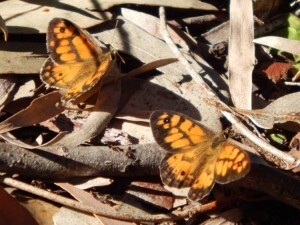
My heart fills.
4.
Butterfly
flutters by:
a living flower.
If you haven’t guessed it , a hay(na)ku is a poem with really only one rule – it has six words (1 word, then two then 3). Small poems, butt hey can say an awful lot.
Now I’m off for that first-thing-Friday swim. How lucky am I? And later I’ll be swimming across the Poetry Friday waves, checking out what my poetic friends have to offer this week. The round up is hosted by Molly – swim on over and ride those waves.
February 13, 2023
Teacher Tuesday: Using A Picture Prompt to Write a Story
It’s Teacher Tuesday – the third one for 2023. After I shared a poem last week, I realised I tend to do lots of sharing of poetry, and poetry writing ideas, but less often other forms and genres.
So, today, I’m sharing a strategy for using a photo as a writing prompt for a story. Note that I prefer the word story over narrative – but given the use of ‘narrative’ in curriculum and in testing, I strongly encourage that you make sure every writer knows that a story IS a narrative. This helps to connect the classroom/curriculum term to what they might experience outside of school.
Using photos and other images is a wonderful way to inspire writing – and also can help prepare your students for tasks such as those in the annual NAPLAN assessments. However, not every writer can look at an image, have a eureka moment and start writing. In fact, I’d argue most of us can’t.

What goes wrong? I’m going to use the above duck image for an example. Often, young minds can be very literal. You are showing me a picture of a duck. Therefore, I must describe the duck. There was once a brown duck and it had a beak. It said quack a lot. The end.
Other times, overthinking happens. I have to write a good story. I need an amazing beginning, lots of action and dialogue. But gosh, I know nothing about ducks, or what can happen to them. I’ve never even met a duck….
A third thing that happens is an attempt to write the same story over and over. I only like stories with goodies and baddies. But you’re asking me to write about a duck? Hmmm. There was once a robber duck. It wanted to steal all the duck food from the other ducks. But the sheriff duck stopped it. The end. No one will notice that this is just like the story I wrote the other day, but this time with ducks instead of people.
How do we avoid these and other pitfalls? By using image prompts regularly, but also giving some structure to how we use them. Here’s one way of doing that.
Show the picture. If possible, have multiple copies so that, as well as being on a screen, writers can also hold the image in their hand. Turning it, pointing to it, manipulating it.Allow talk. Even though in those terrible testing conditions that isn’t possible, building a community of writers involves chances to talk.Guiding questions. These are not questions every child answers out loud, but are prompts to think about – and may be discussed with group members. Try to stress that there are no right answers – this is about possibilities.What can you see? If you were there in the image, what would you hear? Smell? Feel? Taste?What place do you think this is? Is it real, or imaginary? What exists outside the boundaries of the picture?Who is in the image? What might their name be, how old, what do they want? (If there is no character (person, animal or otherwise) – rephrase the question to ask who does this object/building etc belong to?)What might that character want? Need?What is stopping them from getting that? (These two questions are helping to think of a conflict, or complication)How might they overcome that obstacle/problem?By answering these questions a writer can have all they need to develop a narrative – they have a setting, a character and a conflict with a possible resolution. But, along the way, they may have developed several possibilities.
Encourage writers to jot down a one sentence plan (character, conflict, resolution) for their story before they start writing – eg Florence the duck wants a worm for breakfast, and finds one under a rock. Under that sentence, have them write the three things that happen before the problem is resolved – Looks in the pond, looks up a tree, looks over the fence.Start writing. This is the time where the talk can be reduced. Try to build this as something ‘real’ writers do – they plan first, which can be noisy, then they write quietly so they can only read their own thoughts. A writer who is stuck can look back at their very simple plan.Stop and share. A big step that is often missed in writing is giving writers a chance to share their work with each other,. So at the end of the writing session – or at points during it, depending on how long you have – it is vital that young writers get to share their masterpieces with each other. This makes their work purposeful – and fun, too. Structure this sharing has you see fit, but I really encourage it to be not about assessing or scoring.This is a very basic set of steps. You can build them into a lesson, and you can adapt depending on the age group of your class. But you can also use and reuse these steps, so that your writers become really comfortable with the concept of using an image (or some other prop or prompt) to plan a and write.
Ready for another picture prompt? Here’s one of my own photos which might inspire a story or three in your classroom. I’d love to hear if you use it, or the duck image, and how it goes.
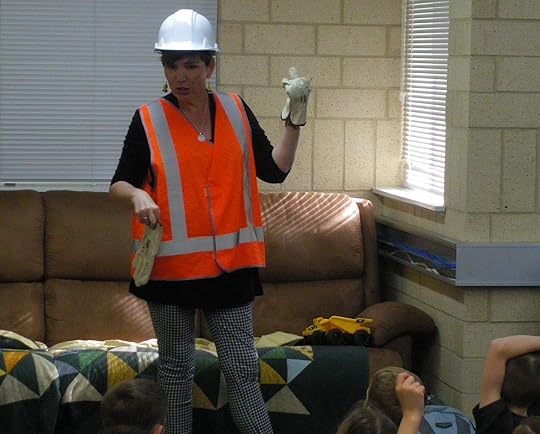
See you next Teacher Tuesday.
February 9, 2023
Poetry Friday: Me and the Sea
It’s Poetry Friday and I am thinking – a lot – about swimming. This is, in part, because in two days I will be participating in the Busselton Jetty Swim, an annual swim around a mile-long jetty. I’ve written about that swim before here. This year will be my seventh time.
I’ve always been a swimmer – I learnt to swim on family holidays by the beach, and in our local swimming pool which, conveniently, was in the street where I lived in a town called Collie. As soon as I was old enough I joined the Collie Swimming Club – starting in Tadpoles and working my way through to being part of the main group and even, at one stage, club captain.
I was a good swimmer – never the best in the club, nor in my age group, but good enough to compete. And I loved it. I loved the feeling of being in the water, and I loved belonging to a swimming club.
When I left school I thought I was too old to be in a club, so my swimming changed to being for leisure, but when I moved back to to the country, I went back to lap swimming whenever time allowed. Then, six or seven years ago, I realised that if I was ever going to fulfil a goal I had of swimming in the annual jetty swim, I’d better get serious.
So I joined the local Masters Swimming Club, put an entry in for the race, and got training. One of the best things I ever did! Since then I have swum each year in that race, but I’ve also rediscovered the absolute joy of swimming. I train with the club when I can, at the pool or at the beach, and I swim by myself other times.
Do I break records? Nope. Do I come out of the water with a big smile on my face? Almost every time. Because for me swimming is not just exercise – it’s therapy. It doesn’t matter how busy I am in my work life, or how worried I am about my family, or how many rejections I’ve had for my writing, or how many deadlines I have – when I am in the water, there is only me, and the water. Of course, when I’m swimming with my clubmates and friends, I’m not truly alone – and when we stop I adore being with them, and laughing and talking about life or empathising about sore muscles – but when I’m actually swimming, it’s just me and the sea (or the pool, but that doesn’t rhyme so well).
I’ve been trying to capture that feeling in a poem. Here’s it’s current form.
Me and the Sea
Splash!
I’m in
And
Stroking
Stroking
Stroking.
Turn head
Breath in
Turn back
Breathe out
And
Stroke
Stroke
Stroke
Breathe in
And out
And stroke
And kick.
There is no one else here
Just me
And the sea
Washing tension from my body
Washing turmoil
From my brain
Stroke
Stroke
Stroke
I am free.
I am me.
(Copyright Sally Murphy 2023)And here’s a poem I wrote about the jetty (and shared here before) that I wrote before I ever swam around it. You can see just what a magnificent structure it is.
Not every one’s a swimmer – but I think most people have something they do that really gives them joy, even if it isn’t always easy. I’d love to hear about yours!
In the meantime I am off to find more joy by reading the poetry of my Poetry Friday friends. Carol has the roundup this week.
February 6, 2023
Teacher Tuesday: My Shadow
Welcome to the second edition of Teacher Tuesday for 2023.
Last week I shared a unit of work for teaching Worse Things in upper primary classrooms. This week I wanted to share a favourite poem that you can share with classes of any age.
Choosing poetry for the classroom doesn’t have to be hard. There are lots and lots of wonderful collections and anthologies. But there are also a lot of poems in the public domain including one of my favourites: My Shadow, by Robert Louis Stevenson.
First, listen to it read, with pictures of my shadow enjoying my local beach.
Feel free to use this video in your classroom – I’d love to know what your students think of the poem, my reading – and my amazing beach.
If you’d like a copy of the words, here they are:
My Shadow
by Robert Louis Stevenson
I have a little shadow that goes in and out with me,And what can be the use of him is more than I can see.He is very, very like me from the heels up to the head;And I see him jump before me, when I jump into my bed.The funniest thing about him is the way he likes to grow—Not at all like proper children, which is always very slow;For he sometimes shoots up taller like an india-rubber ball,And he sometimes gets so little that there’s none of him at all.He hasn’t got a notion of how children ought to play,And can only make a fool of me in every sort of way.He stays so close beside me, he’s a coward you can see;I’d think shame to stick to nursie as that shadow sticks to me!One morning, very early, before the sun was up,I rose and found the shining dew on every buttercup;But my lazy little shadow, like an arrant sleepy-head,Had stayed at home behind me and was fast asleep in bed.What can you do with this poem? Lots of things! Read it aloud to your students – from the early years right through. It is a beautiful poem to read aloud, and fun to learn to recite, too.
But, after you’ve read it, why not link the poem to a science lesson – experimenting with the way that shadows are made by different light sources. Find out why shadows are sometimes bigger or smaller than the person or object. The Science Sparks website has some excellent ideas for classroom activities here.Or, perhaps you want to use the poem as the inspiration for an art lesson. Have students draw around each other’s shadows, for a life size self-portrait. Use a lamp to make shadows of different sized objects and draw around them. Or, go outside and search for shadows.If you want more poems and poetry ideas, you might find these older posts of mine useful:How to Write a Metamorphosis PoemAn Easy Way to Write a PoemWriting a Definition Poem>
If you’ve used My Shadow, or have another wonderful poem or poetry idea, feel free to tell me about it in the comments. Otherwise, I’ll see you next Tuesday.February 5, 2023
What I Read in January 2023
I can’t believe we are already into the second month of this new year. Time flies! It was a busy month – I holidayed, tried to write, swam a lot, walked George, who loves his beach walks especially, spent time with family – and went back to my dayjob too. So I am a little surprised to realise I managed to read 12 books this month, though I did read my way through three flights. I think my favourite book was Reasons Not to Worry (see below), a book I am recommending widely – even though, if I am honest, at the end of this busy month I realised I had not retained anywhere near as many of the lessons it contains as I hoped. I may need to reread it 
Anyway, here’s what I read.
Books for Children
 Trash(Random House, 2014), by Andy Mulligan. Set amongst the trash heaps and hidden world of Manila, where children subsist as best they can, by collecting trash. But Raphael, Gordo and Rat find something they shouldn’t – and it lands them in the midst of an adventure they are not sure they want to be on.
Trash(Random House, 2014), by Andy Mulligan. Set amongst the trash heaps and hidden world of Manila, where children subsist as best they can, by collecting trash. But Raphael, Gordo and Rat find something they shouldn’t – and it lands them in the midst of an adventure they are not sure they want to be on.
 The Bookshop at the Back of Beyond (Walker Books, 2023). This is the third in a series – a fact I missed when I bought it. So it took a little while to get into, but did mostly stand alone as a fantasy adventure involving a travelling house filled with magical (and, in Nine’s case, human) inhabitants.
The Bookshop at the Back of Beyond (Walker Books, 2023). This is the third in a series – a fact I missed when I bought it. So it took a little while to get into, but did mostly stand alone as a fantasy adventure involving a travelling house filled with magical (and, in Nine’s case, human) inhabitants.
 Ming and Flo Fight for the Future , by Jackie French (Harper Collins, 2022). The first title in the Girls Who Changed the World series, this one sees Ming, who bemoans the lack of girls in history lessons, taken back to the late 1800s where she lives the life of Flo Watson, a poor farm girl, but also witnesses the stirrings of change.
Ming and Flo Fight for the Future , by Jackie French (Harper Collins, 2022). The first title in the Girls Who Changed the World series, this one sees Ming, who bemoans the lack of girls in history lessons, taken back to the late 1800s where she lives the life of Flo Watson, a poor farm girl, but also witnesses the stirrings of change.
 The Raven’s Song, by Zana Fraillon & Bren MacDibble (Allen & Unwin, 2022). Two of my favourite authors coming together to write – how could I not adore this book! Set in a post-apocalyptic world, where people live low tech lives in the hopes of restoring the earth – and in the past, in the beginnings of a terrible pandemic.
The Raven’s Song, by Zana Fraillon & Bren MacDibble (Allen & Unwin, 2022). Two of my favourite authors coming together to write – how could I not adore this book! Set in a post-apocalyptic world, where people live low tech lives in the hopes of restoring the earth – and in the past, in the beginnings of a terrible pandemic.
 Runt, by Craig Silvey, illustrated by Sara Acton (Allen & Unwin, 2022). This is delightful. A little reminiscent of stories like Babe – a clever, but slightly damaged dog, and his person, Annie, who together have the ability to save the family farm. Touchingly whimsical, and inspired me to write a blackout poem when I found a chapter about a dog named George.The Snow Queen, by Hans Christian Anderson, narrated by Julia Whelan (Audible). This audio version of the classic was a Christmas bonus with membership – though not a Christmas story. It was interesting to rediscover this story, which I believe inspired the movie Frozen, though the two are very different – which is common with Disney and other modern retellings.
Runt, by Craig Silvey, illustrated by Sara Acton (Allen & Unwin, 2022). This is delightful. A little reminiscent of stories like Babe – a clever, but slightly damaged dog, and his person, Annie, who together have the ability to save the family farm. Touchingly whimsical, and inspired me to write a blackout poem when I found a chapter about a dog named George.The Snow Queen, by Hans Christian Anderson, narrated by Julia Whelan (Audible). This audio version of the classic was a Christmas bonus with membership – though not a Christmas story. It was interesting to rediscover this story, which I believe inspired the movie Frozen, though the two are very different – which is common with Disney and other modern retellings.Books for Young Adults
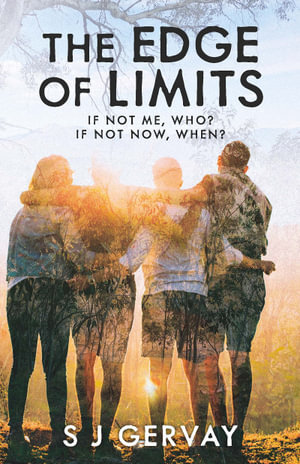 The Edge of Limits, by S. J. Gervay (Flying Elephant media, 2022). I read this book under its previous title The Cave, when it was released quite a few years ago. But it felt like I was reading it for the first time, as I journey along with Sam on a gruelling bush camp. The topics aren’t easy – including sexual assault, violence and grief – but there are light moments, too, and the story is both well told and important. Great to see it back in print.Books for Adults
The Edge of Limits, by S. J. Gervay (Flying Elephant media, 2022). I read this book under its previous title The Cave, when it was released quite a few years ago. But it felt like I was reading it for the first time, as I journey along with Sam on a gruelling bush camp. The topics aren’t easy – including sexual assault, violence and grief – but there are light moments, too, and the story is both well told and important. Great to see it back in print.Books for Adults
 Lessons in Chemistry, by Bonnie Garmus (Penguin, 2022). Recommended somewhere, but also read because I liked the cover, and then the idea of a scientist ending up on a so-called cooking show in the 60s. I enjoyed this, with a combination of issues including some quite heavy ones, and a touch if whimsy, including a very clever dog.
Lessons in Chemistry, by Bonnie Garmus (Penguin, 2022). Recommended somewhere, but also read because I liked the cover, and then the idea of a scientist ending up on a so-called cooking show in the 60s. I enjoyed this, with a combination of issues including some quite heavy ones, and a touch if whimsy, including a very clever dog.
 Reasons Not to Worry: How to be Stoic in chaotic times, by Brigid Delaney (Allen & Unwin, 2022). Oh wow! This book is amazing. Or maybe it came to me at the right time. Or both. A gift from my sister for Christmas, I was initially a little wary – the title and the subject matter (stoicism) made me think it might challenge me – and it did, but in a good way. It had me thinking, and contemplating what I could learn rom this very down to earth, relatable journey through what we can learn from the ancient stoics in modern times. Thoroughly recommend – and I’ll be rereading.
Reasons Not to Worry: How to be Stoic in chaotic times, by Brigid Delaney (Allen & Unwin, 2022). Oh wow! This book is amazing. Or maybe it came to me at the right time. Or both. A gift from my sister for Christmas, I was initially a little wary – the title and the subject matter (stoicism) made me think it might challenge me – and it did, but in a good way. It had me thinking, and contemplating what I could learn rom this very down to earth, relatable journey through what we can learn from the ancient stoics in modern times. Thoroughly recommend – and I’ll be rereading.

Different, Not Less: A neurodivergent’s guide to embracing your true self and finding your happily ever after, by Chloe Hayden (Audible, 2022). I have bene doing quite a bit of reading about neuodivergence in recent months, and I found this one an excellent insight. I read the Audible version, read by the author, which was an added bonus. Hayden gives an open insight into her life with autism and adhd, but also offers help to fellow sufferers, and a helpful insight for others.
 4. A Philosophy of Walking, by Frederic Gros (Verso, 2015). I do love walking, so was quite excited to read this book. It was a little different than I expected, as I soon realised that my morning walks are not necessarily what Gros would call walking, given that I do them partly for exercising and walking my dog. He might call this strolling, perhaps. That aside, it was interesting to delve into why people walk, and how great philosophers of the past used walking to think, to breathe and to travel, too.
4. A Philosophy of Walking, by Frederic Gros (Verso, 2015). I do love walking, so was quite excited to read this book. It was a little different than I expected, as I soon realised that my morning walks are not necessarily what Gros would call walking, given that I do them partly for exercising and walking my dog. He might call this strolling, perhaps. That aside, it was interesting to delve into why people walk, and how great philosophers of the past used walking to think, to breathe and to travel, too.
January 31, 2023
Teacher Tuesday: Worse Things
Welcome to a new school year. If you are in Australia, and are a teacher, chances are you are busily greeting your new students this week. So it seems a good time for me to reintroduce something I used do regularly pre-covid, a weekly feature called Teacher Tuesday.
How it works is that each Tuesday I will endeavour to share something that will help teachers to use one or more of my books or poems, or perhaps books and poems more broadly, in the classroom. Sometimes it will be brand new content. Other times it will be helping you to discover – or rediscover – content that has been shared elsewhere.
To kick things off, this week I want to share an excellent unit of work developed by PETAA for my verse novel Worse Things (published by Walker Books and illustrated by the amazing Sarah Davis).
You will find this unit of work, aimed at year 5 and 6 English curriculum outcomes, here. What does it offer? Lots of big picture ideas, close reading, word knowledge, ideas for writing and creating, and more. While you are there, I encourage you to browse the rest of the PETAA site and, if you aren’t already a member, to consider joining.
Not familiar with Worse Things? Here’s a taste – me reading chapter one during the first Covid lockdown back in 2020.
As well as the above unit of work, Worse Things is suitable for reading aloud to classes from about year 4 through to junior high, as well as for individual reading. You’ll find more ideas here, at the Walker Books website.
Have you read or taught http://sallymurphy.com.au/worse-things/? I’d love to know how you went, and if you have any ideas for sharing. Leave a comment.
January 26, 2023
A Cover Reveal: Queen Narelle is coming
Can you hear the trumpets sounding?
Da da da daaaaaaa.
Can you hear the drums drumming?
Bom bom bom bom bom bom bom bom
Can you hear the people cheering?
Hurrah hurrah hurrah hurrah hurrah
(You can’t? Well you’ll just have to imagine then!)
Please rise and welcome…
Queen Narelle!
Who is Queen Narelle? Well, as well as being the title of my upcoming verse novel, she is also a rather delightful, clever, and very regal cat. And today she is here because it is cover reveal day!
And, rather than keeping you (and Queen Narelle) waiting, here it is:

Isn’t it lovely? Simon O’Carrigan has done a beautiful job of bringing my little cat to life. And the design team at Walker Books have then worked some extra magic to make the cover simply scrumptious.
You do have to wait a little longer to find out what’s inside that cover – release date is June 3 – but I look forward to sharing Narelle’s story, as well as that of her human, Maddie, with readers of all ages.
It’s extra fitting that I am revealing the cover today, because Queen Narelle is a verse novel, and, of course, today is Poetry Friday. So, to top off the celebration, I thought I’d share a couple of cat poems. One of my own – Marmalade and Marmaduke – published in the School Magazine and then brought to life with a reading by Geoffrey McSkimming, and artwork by Matt Ottley.
and another, a favourite from my childhood, by Eleanor Farjeon
Cats Sleep Anywhere
Cats sleep anywhere,
Any table, any chair
Top of piano, window-ledge,
In the middle, on the edge,
Open drawer, empty shoe,
Anybody’s lap will do!
Fitted in a cardboard box,
In the cupboard, with your frocks-
Anywhere! They don’t care!
Cats sleep anywhere.
I do love cat poems – and, while my dog George is less impressed, I cannot wait to share Queen Narelle with you, in paperback and in ebook format in June.
Want more poems? Come with me – I am off to pounce on the delights of Poetry Friday, with the Roundup hosted by Jan at Bookseed Studio.



